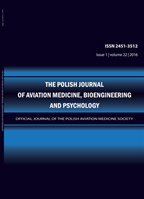2016, Volume 22, Issue 4
A MODELLING APPROACH TO THE HUMAN PERCEPTION OF SPATIAL ORIENTATION
Rafał LEWKOWICZ1
-------------------------------------------------------------------------------------------------
1Simulator Study and Aeromedical Training Division, Military Institute of Aviation Medicine
Autor korenspondencyjny: Rafał LEWKOWICZ; Simulator Study and Aeromedical Training Division, Military Institute of Aviation Medicine; email: rlewkowicz@wiml.waw.pl
Full text
Streszczenie
Introduction: In comparison to high level of knowledge of aircraft dynamics, the knowledge of a pilot in the human – aircraft system still appears to be insuffi cient. There have been a wide variety of studies and models describing the human’s behavior and perception, especially in the fl ight environment. However, only few of them concern the dynamics of spatial orientation perception. This article deals with one of the most important aspects of aviation physiology. The aim of this paper is to consolidate information on the methods for modelling of the human perception of spatial orientation. This knowledge could be useful for further model’s development.
Methods: Systematic review, including publications, conference materials, chapters in books, diploma theses, doctoral dissertations and reports available in electronic databases.
Results: Most of the models of the human perception of spatial orientation currently use one of three techniques for perception estimating: state observer, Kalman’s fi lter and Bayesian estimation. These models are able to mimic orientation perceptions, linear and circular vection, rotation and acceleration in the light, as well as estimate vestibular-ocular refl ex.
Conclusions: The methods for modelling the perception of spatial orientation could be useful in better understanding of the human’s natural ability to determine and maintain the position of the body in relation to the surrounding environment. A multi-sensory model of the human perception of spatial orientation is a tool that could be helpful for recognizing misperceptions during active and passive motion , as well as in other areas related to e.g. motion sickness.
Słowa kluczowe
spatial orientation, perception, modelling, self-motion perception, vestibular system
